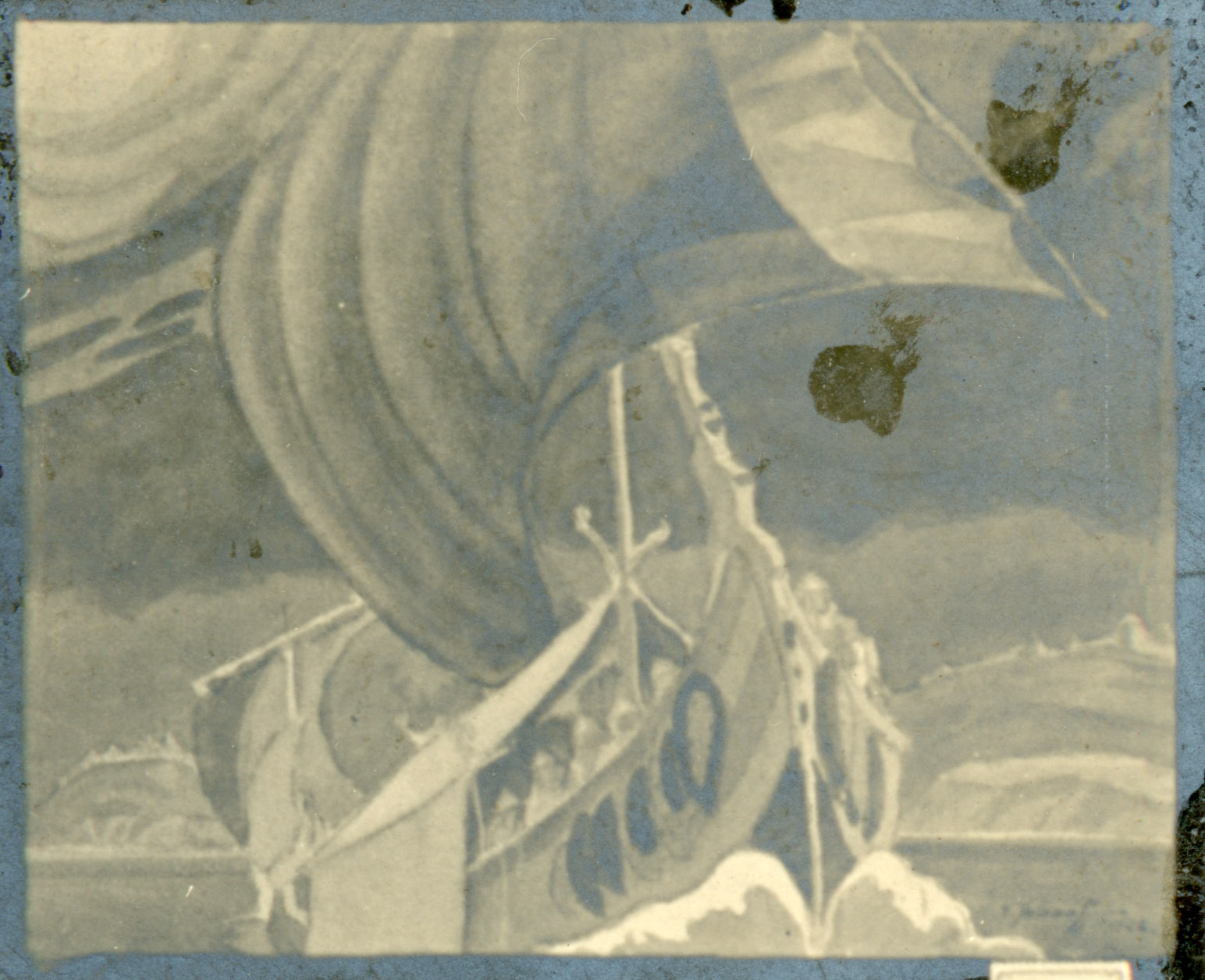Archive
Wladimir Ivanoff
- Wladimir
- Ivanoff
Владимир Степанович Иванов, Vladimir Ivanov, Vladimir Ivanoff
- 1885
- Dnipro (UA)
- 22-12-1964
- New York City (US)
- PainterSculptor
Not only did Ivanoff become one of the founders and chairman of the Union of Russian Painters in Constantinople, but he also became famous for “Drawing Thursdays”, which took place at his apartment.
Word Count: 33

Members of the Union of Russian Painters in Constantinople, Summer 1922. Presumably one of the men in this picture is Wladimir Ivanoff. Source: Scrapbook “To Mr. and Mrs. Stearns from Russian Painters”, p. 8 (Stearns Family Papers. Archives & Special Collections. The College of the Holy Cross). 
Members of the Union of Russian Painters in Constantinople, Summer 1922. Presumably one of the men in this picture is Wladimir Ivanoff. Source: Scrapbook “To Mr. and Mrs. Stearns from Russian Painters”, p. 8 (Stearns Family Papers. Archives & Special Collections. The College of the Holy Cross). 
Photograph of the artwork by Wladimir Ivanoff (most likely). Source: Scrapbook “To Mr. and Mrs. Stearns from Russian Painters”, p. 16 (Stearns Family Papers. Archives & Special Collections. The College of the Holy Cross). Anonymous. “Odnodnevnaya Vystavka Kartin.” Presse du Soir, 10 October 1921, p. 4.
Anonymous. “Vystavka Kartin.” Presse du Soir, 20 October 1921, p. 4.
Anonymous. “Vystavka Soyuza Russkih Hudojnikov.” Presse du Soir, 19 June 1922, n.p.
Bournakine, Anatoliy, and Dominic Valery, editors. Al’manah Na Proschaniye. The Farewell Almanac. L’Almanach Nos Adieux (1920–1923). Imp. L. Babok & fils, 1923.
Leykind, Oleg, et al. Hudojniki Russkogo Zarubej’ya (1). Izd.dom “Mir”, 2019, p. 565.
Novitskiy, G. “Pamyati hudojnika W.S. Ivanova.” Novoye Russkoye Slovo, 23 December 1965, n.p.
Ted’. “K Vystavke Hudojnikov.” Presse du Soir, 29 June 1923, n.p.
Zavalishin, Vyacheslav. “V studii Wladimira Ivanova.” Novoye Russkoye Slovo, 19 November 1964, n.p.
Word Count: 97
Archives & Special Collections at the College of the Holy Cross (Worcester, Massachusetts).
Slavonic Library (Slovanská knihovna) in Prague.
Word Count: 19
Istanbul, Ottoman Empire/Turkey (?–1923); New York, USA (1923–1964).
Küçük Yazıcı 4 (now presumably Tarlabaşı Blv. 79), Hüseyinağa, Beyoğlu, Istanbul (studio).
- Istanbul
- Ekaterina Aygün. "Wladimir Ivanoff." METROMOD Archive, 2021, https://archive.metromod.net/viewer.p/69/2949/object/5138-10440389, last modified: 14-09-2021.
-
Nikolai SaretzkiPainterGraphic ArtistIllustratorArt CriticCollectorScene DesignerIstanbul
Saretzki took a rather long exile route: from the Russian Empire he fled to Istanbul, from Istanbul to Berlin, from Berlin to Prague, and from Prague to Cormeilles-en-Parisis near Paris.
Word Count: 30
Nikolai KalmykoffPainterScene DesignerMuralistIstanbulKalmykoff played an active part in the Union of Russian Painters in Constantinople and at the same time worked as a stage designer. Later he acquired the Turkish citizenship.
Word Count: 29
First Russian émigré artists in Istanbul exhibitionExhibitionIstanbulThe first Russian-speaking émigré artists in Istanbul exhibition was a one-day event but its success led to the formation of the Union and paved the way for other exhibitions.
Word Count: 29
Exhibition of Russian émigré artists at Taksim Military BarracksExhibitionIstanbulThe exhibition of Russian-speaking émigré artists at Taksim Military Barracks was the first major exhibition organised by the Union of Russian Painters in Constantinople.
Word Count: 24
Union of Russian Painters in ConstantinopleAssociationIstanbulThe Union existed for less than two years but in that short space of time a tremendous amount of work was done by its members, refugees from the Russian Empire.
Word Count: 30
Nikolai BeckerPainterGraphic ArtistIstanbulNikolai Becker worked tirelessly in Turkey for three years. He created at least 168 portraits of men and women (among them admirals and their families, commanders-in-chief, diplomats, etc.).
Word Count: 27
Nikolai VasilieffPainterScene DesignerMuralistIstanbulVasilieff was not only one of the Union of Russian Painters in Istanbul’s leaders, but he is also remembered for his stage settings and costumes for the ballet Scheherazade at the Theatre des Petits Champs.
Word Count: 36
Vladimir BobritskyPainterScene DesignerGraphic ArtistMusicianIstanbulBobritsky worked at the Theatre des Petits Champs, where he successfully dealt with stage designs and costumes, at the same time he participated in the Union of Russian Painters in Constantinople.
Word Count: 31